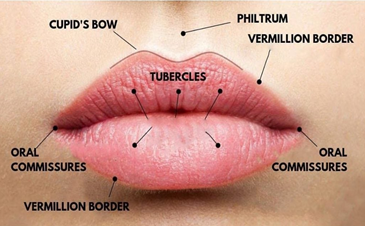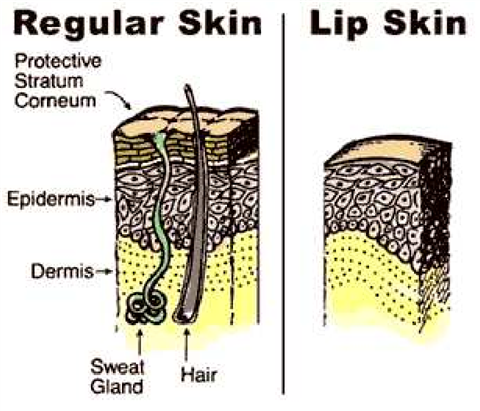Introduction
Cosmetics play an important function in today's standards of life.1 Herbal lip balm is a type of lip balm made from natural herbs and ingredients. In addition to protecting and moisturising the lips, the herbs employed in its formulation provide additional benefits. Typically, a combination of oils and waxes, including olive oil, coconut oil, beeswax, and shea butter, are included with herbs in herbal lip balm. Together, these components provide a nourishing and protective layer for the lips.2
Lips have distinct structure from the skin. Typically, the skins top corneum layer has 15 16 layers, most of which serve as protection. In contrast, the top corneum layer of the lips contains only approximately 3–4 layers and is incredibly thin compared with ordinary facial skin. The skin of the lips contains very few melanin cells. As a result, blood vessels are more visible through the skin of the lips, giving them a lovely pink. Sweat glands and hair follicles are absent on the lips. Therefore, it does not contain body lipids or sweat that would typically protect the body from the environment.
Lip anatomy
It is made up of the mucous membrane, areolar tissue, orbicularis muscle, superficial fascia, and skin. Dry, red mucous membrane that is continuous with the skin and has many touch corpuscles and vascular papillae covering the lip edges. (Figure 1)
Vermillion border
Latin terms labium superius oris and labium inferius oris refer to the anatomical names for the upper and lower lip, respectively. 3 The lower lip includes the area between the lateral commissures and the labiomental crease of the chin, although considerations of the lips are typically focused on the vermilion zone. The upper lip extends from the nasolabial folds to the inferior border of the nose.
Tubercles
The tubercle or procheilon is the underlying fleshy fullness of the philtrum, which forms the downward arch of the cupid's bow.
Oral commisures
The commissure is the point where the upper and lower lips meet at the mouth angle. Several muscles used in lip movement attach at this location.
Philtrum
A symmetrical pair of paramedian vertical philtral ridges that surround the philtrum, a central depression, are features of the upper lip. Dermal collagen and thick elastic tissue combine to generate a special collection that forms the philtrum and philtral ridges. It is thought that the philtrum provides extra skin that can be pulled into oral movements that need upper lip stretching. 4
Properties of lips: (Figure 2)
There are no sebaceous (oil glands on the lips
The lips have no hair follicles and no sweat glands
The layers of skin on the lips are extremely thin
(3To 5)
People with darker skin have some pigment, so the red hue of their lips is less noticeable.
Lips do not contain skin pigment, so blood vessels can be seen through the thin skin and make the lips appear red.
Due to their abundance of nerve endings, lips are sensitive to temperature, touch, and light.
8. Because there are no direct bony attachments to lips, they are incredibly elastic and malleable. 5
Advantages of natural lipbalm
Lip balms contribute to maintain the lips' natural health and beauty.
Sunblock lip balms have been proven shown to protect the lips from UV radiation.
Both men and women can use these goods; they are not gender-specific.
Lip balm products aid in preventing chapping, dryness, and cold sores on the lips.
The product should produce a uniform layer over the lips to shield the labial mucous from external elements such pollution, dryness, and UV radiation.
It should not generate friction or a dry feeling when it comes into contact with the skin.
It relieves lip-related problems brought on by colds, the flu, and allergies while also rejuvenating and refreshing the lips.
Treating the skin's condition and facial look with natural lip cosmetics.
Disadvantages of natural lipbalm
Low-quality lip balms can cause serious harm to the lips, drying them out instead of moisturizing them.
Another drawback of using lip balms is that they tend to become addictive.
Homemade lip balms usually disappear from the lips more quickly than those produced in a manufacturing acility. Hence, you must frequently reapply.
Some lip balm manufacturers manufacture lip balms with the sole intention of appealing to the aesthetic, ignoring the health benefits and softness of the skin.
The naturally derived colors and flavors are more difficult to obtain and have stability issues in the products
Materials and Methods
Fresh beetroot was procured and ground to get fresh beetroot juice.
2 ml of beetroot juice was taken and Added 3.5 ml of Coconut oil this was heated with occasional stirring.
When the beetroot juice starts to caramelize, the heat was reduced.
The mixture was then transferred to a china dish.
Into another china dish beeswax, lanolin and cocoa butter was added & heated to 70℃ by double boil method.
This mixture was then added with beetroot juice & coconut oil.
Mixture and stirred continuously until a smooth consistency were obtained.
The above preparation was transferred to a suitable container and allowed to cool in a refrigerator.
This can be used as a lip balm and also as a substitute for a lipstick. Make sure your hands are clean when using this lip balm.
Evaluation Parameters
Organoleptic characteristics:
The lip balm's tastes, appearance, odour, and colour were all evaluated.
Spreadability test
А spread-ability test was conducted by spreading lip balm to a glass slide, and any deformation and breakdown were evaluated in compliance.
Melting point
The material was heated to a molten condition and then put into capillaries to determine the melting point. A device with a thermometer attached to it was connected to the capillaries. The melting point of the lip balm sample was found to be the temperature at which melting occurred.6
Result and Discussion
This lip balm formulation was aimed to incorporate natural ingredients as much as possible to retain the natural properties of the balm. Conventional lip balms can contain toxic substances, such as petrolatum, synthetic waxes, alumina, parabens, hydrogenated oils, artificial fragrances, and colors. To avoid these, we used beetroot to give the balm a natural colour. We evaluated the lip balm for its melting point, pH, spreadability, and stability studies. The results showed a melting point of 64°C and a pH of 6.4. The balm had good spreadability and did not deform. Stability studies conducted at different temperatures for one month revealed that the lip balm maintained its uniformity, and perfect application, and did not fragment or deform at room temperature and in the refrigerator.7, 8, 9
Conclusion
It was observed that the formulation remained stable when stored at room temperature and in the refrigerator, demonstrating consistent stability behaviour. The product's organoleptic characteristics were also found to be stable, and it had good spreadability. The storage conditions were considered appropriate as they helped in maintaining the product's functionality. In the stability test, it was noted that the lip balm made from natural ingredients had a suitable melting point, averaging 64°C. Based on these observations, it can be concluded that the natural ingredients used in the formulation of the lip balm were safe for use. Moreover, the combination of natural ingredients was found to be a better option for lip balm formulation. Furthermore, altering or combining ingredients can result in new formulations with different and enhanced quality.7, 10


